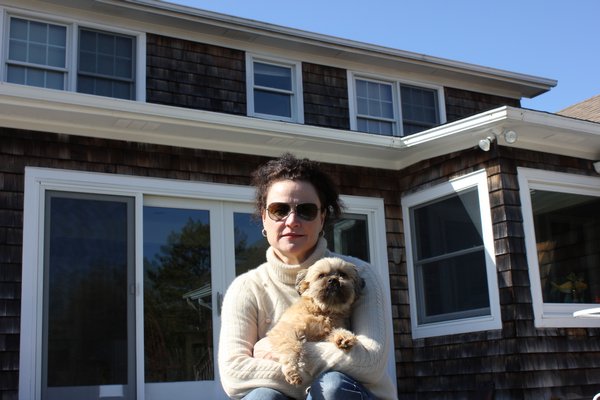
When Quogue resident Eileen Duffy inherited her parents’ home in 2013, she also inherited the two-story house’s more than 50-year-old septic system.
Through the Reclaim Our Water Initiative, Ms. Duffy would be eligible for a county grant of up to $11,000 to help defray the cost of replacing her cesspool with an alternative nitrogen removal onsite wastewater treatment system, or I/A OWTS. However, she rents out her home, located at 10 Barker Lane, for the month of August, making her ineligible.
In 2016, the Suffolk County Septic Improvement Program, or SIP, authorized $2 million a year for five years to subsidize I/A OWTS installations for eligible county residents, according to Grace McGovern, the spokeswoman for the Suffolk County Department of Health Services.
Residences must be single-family homes and served by a septic system or cesspool not connected to a public sewer, to meet the program’s criteria. A household’s adjusted gross income can not exceed $300,000 a year in order to be eligible for 100 percent of the grant.
“This is my primary residence and I live here year-round,” Ms. Duffy argued. She added that her single-family 3,647-square-foot home is located in a high-priority area—as defined by Southampton Town’s Water Quality Improvement Project Plan. “You want to help clean up the bays, but I’m disqualified?”
Suffolk County Legislator Bridget Fleming said last week that the intent was never to eliminate short-term rental properties from the program. She explained that the Suffolk County Department of Health Services, which processes the grant applications, is currently reviewing its policy to possibly expand the rebate to include owner-occupied properties that are occasionally rented for short periods.
“The health department is still making tweaks to ensure that the program works best for everyone,” Ms. Fleming, who is in favor of the expansion, said, noting that the expansion would not require a change in legislation. “I know out east many people rely on the ability to rent their houses for a short time to cover their costs.”
Since the alternative systems—which run in the ballpark of $19,200—have been approved by the county for installation, only 168 of 1,045 applicants have secured a county grant certificate, Ms. McGovern said. Of those, only 13 Suffolk County residents have had low-nitrogen systems installed and 15 installations are waiting to be scheduled, she added.
According to Jason Elan, a spokesperson for Suffolk County Executive Steve Bellone, Suffolk County was recently awarded an additional $10 million from the state to help fund I/A OWTS—namely, those approved by the Department of Health Services.
“We will explore the feasibility of expanding this first of its kind water quality program for even more residents,” Mr. Elan said in a prepared statement.
To date, 14 low-nitrogen treatment systems have been approved by Suffolk County—including the Hydro-Action system, which is manufactured by Septic Systems Inc. of Illinois; Norweco Singulair and Norweco Hydro-Kinetic, manufactured by Norwalk Wastewater Equipment Company Inc. in Ohio; Orenco, manufactured by Orenco Wastewater Solutions in Oregon; and Fuji Clean, manufactured by Fuji Clean USA in Maine—according to the Reclaim Our Water Initiative.
The Quogue Village Board recently passed a law, mirroring Southampton Village’s recently adopted law regarding septics, requiring homeowners residing in high- and medium-priority areas to install I/A OWTS when making substantial changes to existing septic systems.
At a recent board meeting, Quogue Village Mayor Peter Sartorius pointed to nitrogen-rich effluent leaching from antiquated and non-functioning cesspools as the primary culprit for the current conditions of the Quogue Canal, and Quantuck and Shinnecock bays.
Ms. McGovern said the alternative wastewater treatment systems discharge “significantly less” nitrogen than conventional septic systems.
“If there are rebates that can help install something that puts way less nitrogen into the bays, I’m going to take advantage of it,” Ms. Duffy added.
In the meantime, Ms. Duffy can apply for rebates through Southampton Town’s Community Preservation Fund Water Quality Improvement Project Plan, or WQIPP, which can use up to 20 percent of Community Preservation Fund revenues to help finance the installation of I/A OWTS in both medium- and high-priority areas.
According to Southampton Town Supervisor Jay Schneiderman, the town does not require that residents occupy their house year-round. He added that income-eligible residents—those who earn less than $300,000 a year—can be awarded up to $15,000 in rebates through the program.
If residents earn between $300,001 and $500,000 per year, up to 50 percent of the cost to a maximum of $15,000 is available.
Still, if the Suffolk County rebate is not expanded to include short-term rental properties, Ms. Duffy is skeptical that she will be able to upgrade her septic system. She said this week that she was planning on applying to both SIP and WQIPP to cover the cost of replacing her aging cesspool.
“I’m going to have to crunch the numbers,” Ms. Duffy said, adding that she has not yet had an engineer visit her property for an estimate. “I want to make sure I can secure a rebate before I start doing all the rest of the work.”